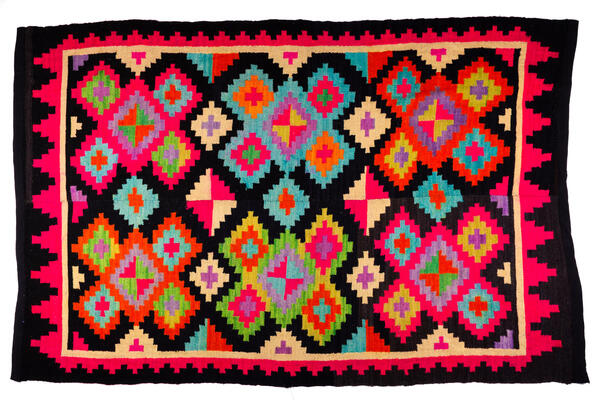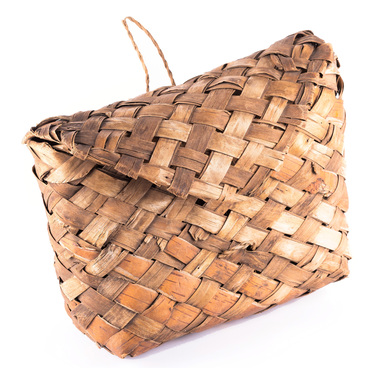Producing mats and rugs has always been widespread in the traditional Bashkir weaving craft. There are two types: napped and napless. The museum’s collection has a napless Bashkir woven woolen rug on display that was made in the XX century. Napless woven woolen rugs were mostly made from goat hair, and less frequently from sheep hair. Most often, Bashkir rugs were woven together from several narrow sections, which were then sewn together. Usually, this kind of woven rug consisted of 5–6 sections, but there were sometimes as many as 8.
Generally speaking, two-three colors prevailed in the patterns on a Bashkir woven woolen rug, and preference was given to warmer colors. Bashkirs often wove rugs that had a pattern with alternating, non-patterned, multi-colored stripes. The designs in the artistic composition of these carpets are rhythmic combinations of the stripes themselves. Most often, warm colors were used in to design these carpets: brown, white, lilac, and pinkish gold. These rugs were often used to decorate Bashkir homes, and they covered the furniture and floors.
Carpets woven from patterned stripes were also widespread among the Bashkirs. These types of woven woolen rugs had simple geometric patterns that were similar to those used in the design of woven towels and curtains. Bashkir carpets are often encountered in which the patterns alternate diagonally. There are also national carpets that are completely covered with patterns. Their edges are usually smooth, and the entire pattern on these carpets consists of star patterns that are tightly fitted together.
The background of Bashkir carpets is often black: this color is also the background color on the carpet on display in the Ethnography Hall. Using the color black, the weavers achieved a contrast with the background channels in the construction of the pattern to create a spectacular carpet composition. The coloring in these patterns are usually clean and very bright - they often use crimson, orange, green, blue, red, and terracotta colors in the patterns. Patterned woven rugs were often used to decorate the walls of dwellings, while bunks or benches were covered with striped carpets, as was the floor in the guest room or the yurt.
Generally speaking, two-three colors prevailed in the patterns on a Bashkir woven woolen rug, and preference was given to warmer colors. Bashkirs often wove rugs that had a pattern with alternating, non-patterned, multi-colored stripes. The designs in the artistic composition of these carpets are rhythmic combinations of the stripes themselves. Most often, warm colors were used in to design these carpets: brown, white, lilac, and pinkish gold. These rugs were often used to decorate Bashkir homes, and they covered the furniture and floors.
Carpets woven from patterned stripes were also widespread among the Bashkirs. These types of woven woolen rugs had simple geometric patterns that were similar to those used in the design of woven towels and curtains. Bashkir carpets are often encountered in which the patterns alternate diagonally. There are also national carpets that are completely covered with patterns. Their edges are usually smooth, and the entire pattern on these carpets consists of star patterns that are tightly fitted together.
The background of Bashkir carpets is often black: this color is also the background color on the carpet on display in the Ethnography Hall. Using the color black, the weavers achieved a contrast with the background channels in the construction of the pattern to create a spectacular carpet composition. The coloring in these patterns are usually clean and very bright - they often use crimson, orange, green, blue, red, and terracotta colors in the patterns. Patterned woven rugs were often used to decorate the walls of dwellings, while bunks or benches were covered with striped carpets, as was the floor in the guest room or the yurt.



